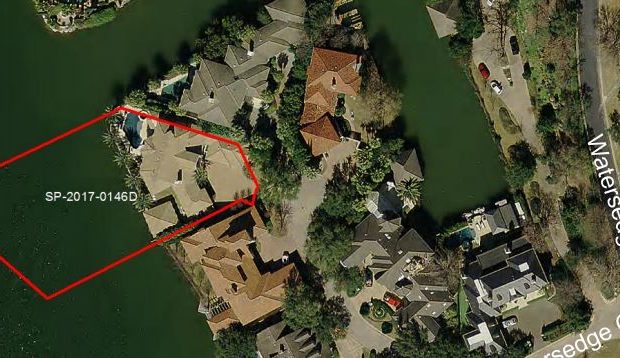Request for lakefront bulkhead variance creates new questions
Wednesday, November 22, 2017 by
Jessi Devenyns It’s not often that a request for a variance from the city’s code has no predecessors against which it can be compared. At the Environmental Commission meeting on Nov. 15, this unlikely scenario became reality.
Janis Smith, civil engineer and representative for the owner of 4213 Waters Edge Cove, came to the Environmental Commission seeking a variance that would allow an already-constructed concrete bulkhead to stay in place, despite the fact that its 12-inch width exceeded the 6 inches allowed under city code. Smith explained that a contractor they had hired had constructed the bulkhead without first taking out proper permits.
Based on the apparent urgency of the situation and a lack of willingness to penalize a homeowner for the oversight of a contractor, the Environmental Commission voted unanimously to recommend approval of the variance.
Smith said that the larger bulkhead was required because 6 inches was not sufficient for the structural stability of the wall. The project proceeded without the proper permits since the contractor on the job believed that the disintegrating bulkhead was an imminent threat to the property. In the end, she said, building the wall before requesting a variance did more good than harm.
“There are no adverse environmental impacts,” she said. “To the contrary, the wall fixed a failing bulkhead, which was leaking soil into the lake, and prevented a potential wall failure.” The new wall elevated the property’s flood plain rating from good to excellent.
Atha Phillips, the environmental program coordinator for the Development Services Department, explained that staff was recommending this project for approval because the bulkhead in question did not affect water quality and no critical environmental features were on the construction site that could be obstructed by the new bulkhead. Staff did add a caveat that the homeowner must provide “twelve 1-gallon plantings, beyond what is currently required by code” to compensate for the additional area the larger bulkhead occupies and help with water filtration.
Despite staff’s recommendation for approval, Phillips said, “the proper thing for (the owner) to do was a couple of months before the drawdown to request a permit.” Generally, however, going through the proper channels to request a permit to construct with variance from the code can take four months after the site plan has been approved, according to Chuck Lesniak, an environmental officer with the Watershed Protection Department.
Commissioner Andrew Creel said that environmentally it appears like the homeowners made the right decision. “Had they followed the process it seems like they would not have been able to finish before the lake came back up,” he said.
Lesniak noted that an advance notification of the lake drawdown was sent out in September to lakefront property owners. The drawdown occurred in January. The letter reminded property owners that all impending work during the lowering of the lake required permits. He also said that if the bulkhead was actively failing, the owner’s request for variance would have been expedited.
Phillips said about the project, “I don’t know if it was an emergency.”
Commissioner Linda Guerrero noted that lake drawdowns are historically when the most egregiously damaging work happens. She explained that this tendency is why there needs to be more oversight for the contractors who are working on projects alongside the lake.
According to staff, only about five contractors regularly work on projects that have to take into account regulations surrounding the waterway.
Lesniak said that as it currently stands, contractors are kept in line mainly by word of mouth. “The fine to the contractor is hopefully word will get around and people will choose contractors that don’t create problems like this.” He noted that with the small universe of contractors who work on these projects “we have the same repeat offenders.”
However, as the final responsibility for these projects following procedure falls on the homeowner, rather than the contractor doing the work, Lesniak said, “I’m reluctant to make a recommendation that is done as a deterrent or a punishment.” According to him, the homeowners did the right thing by self-reporting this case.
Photo courtesy of the city of Austin.
The Austin Monitor’s work is made possible by donations from the community. Though our reporting covers donors from time to time, we are careful to keep business and editorial efforts separate while maintaining transparency. A complete list of donors is available here, and our code of ethics is explained here.
You're a community leader
And we’re honored you look to us for serious, in-depth news. You know a strong community needs local and dedicated watchdog reporting. We’re here for you and that won’t change. Now will you take the powerful next step and support our nonprofit news organization?











